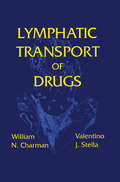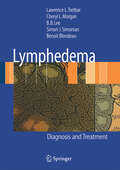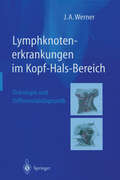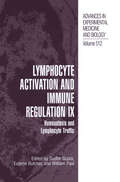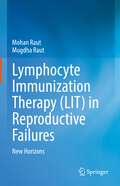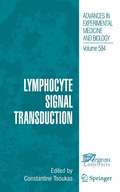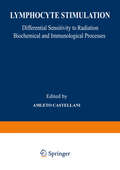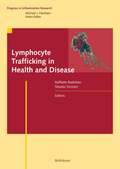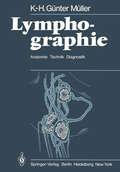- Table View
- List View
Lymphatic Transport of Drugs
by William N. CharmanLymphatic Transport of Drugs provides a thorough review of the determinants that affect the uptake and delivery of drugs and xenobiotics to the lymphatics. Factors affecting the transport and delivery of lipophilic drugs through the lymph after oral administration, lymphatic transport of polar drugs and macromolecules after gastrointestinal dosing, transport of drugs into the lymph after parenteral administration, and particulate drug delivery systems are among the topics examined in this volume. Lymphatic Transport of Drugs is primarily intended for pharmaceutical scientists who are attempting to alter the delivery of current therapeutic agents through formulation of prodrugs, as well as for researchers designing new drugs for lymph delivery.
Lymphatic Transport of Drugs
by William N. CharmanLymphatic Transport of Drugs provides a thorough review of the determinants that affect the uptake and delivery of drugs and xenobiotics to the lymphatics. Factors affecting the transport and delivery of lipophilic drugs through the lymph after oral administration, lymphatic transport of polar drugs and macromolecules after gastrointestinal dosing, transport of drugs into the lymph after parenteral administration, and particulate drug delivery systems are among the topics examined in this volume. Lymphatic Transport of Drugs is primarily intended for pharmaceutical scientists who are attempting to alter the delivery of current therapeutic agents through formulation of prodrugs, as well as for researchers designing new drugs for lymph delivery.
Lymphedema: A Concise Compendium of Theory and Practice
by Byung-Boong Lee, John Bergan and Stanley G. RocksonLymphedema: A Concise Compendium of Theory and Practice brings into one volume the most important sources of information to guide the evaluation and treatment of patients with lymphedema. The management of chronic lymphedema continues to challenge both patients and treating physicians worldwide. In the past decades, however, substantial progress has been achieved for both diagnosis and therapy of these disabling conditions. With increasing attention to the quality of life, this debilitating life-long disease is receiving more attention not only by lymphedema specialists, but also by clinicians across the spectrum of health care delivery. Lymphedema: A Concise Compendium of Theory and Practice provides clear, concise background and recommendations in an easy-to-use format. It is a valuable reference tool for clinical practitioners (physicians/nurse practioners/technicians) who wish to deliver state-of-the-art health care to their patients with lymphatic and venous disorders.
Lymphedema: Presentation, Diagnosis, and Treatment
by Arin K. Greene Sumner A. Slavin Håkan BrorsonThis volume is a clinically-oriented book that can be used for patient care, teaching, or research. It covers the entire field of lymphedema, including both primary and secondary disease, as well as all diagnostic and treatment modalities. The text begins with a foundation for the condition, including its pathophysiology, epidemiology, and morbidity. Next, the classification of lymphedema is covered which is the template for accurate diagnosis. Clinical, radiological, and differential diagnosis of lymphedema is also reviewed. Finally, conservative and operative management is presented, including both physiologic and excisional procedures.Lymphedema: Presentation, Diagnosis, and Treatment provides a comprehensive, easy-to-read reference for any health care provider managing a patient with lymphedema. The text is clinically-focused, evidence-based, and practical. The reader, regardless of his/her level of training or specialty, will be able to adequately treat a patient with lymphedema using this resource. To facilitate its use in clinical settings, the book was designed to be portable. In addition, diagnostic and treatment algorithms are included to further simplify the management of these patients. Patient images are presented throughout the text to illustrate the clinical care of lymphedema. All chapters are written by experts in the field, and contain the most current information on the topic.
Lymphedema: A Concise Compendium of Theory and Practice
by Byung-Boong Lee Stanley G. Rockson John BerganThe second edition of this book serves as a central source of theoretical and practical knowledge to optimize the evaluation and treatment of patients with lymphedema. The book covers all aspects of the disease from anatomical and histological features to diagnosis as well as physical/medical and surgical management of the disease. Updated from the first edition to reflect the substantial progress in diagnostics, medical care and surgical intervention for this patient population, this volume has been reorganized to meet today’s practice requirements. It addresses the challenges faced by clinicians in the management of chronic lymphedema enabling them to meet the medical needs of this large patient community. Edited by world leaders in Vascular Medicine and Surgery, this comprehensive volume provides clear, concise background and recommendations in an easy-to-use format. It is a valuable reference tool for clinical practitioners (physicians/nurse practitioners/technicians) who wish to deliver state-of-the-art health care to their patients with lymphatic and venous disorders.
Lymphedema: Diagnosis and Treatment
by Lawrence L Tretbar Cheryl L. Morgan Byung-Boong Lee Simon J. Simonian Benoit BlondeauA comprehensive, evidence-based introduction to the area of lymphology, the book is directed mainly to the US audience and will appeal to an interdisciplinary field of health professionals. It describes the unique anatomy and physiology of the lymphatic system and the intimate relationship it shares with the venous system. It explores the differential diagnosis of the "swollen leg/arm", which is often the presenting problem to the health care professional. The necessity of history taking, physical examination and laboratory studies are noted. Treatment methods are described as an introduction and psychosocial and quality of life issues are explored in depth.
Lymphgefässsystem Lymphatisches Gewebe: Diagnostik mit bildgebenden Verfahren (Klinische Radiologie)
by M. Gebel K. Helmke E. Kaiserling K.-H.G. Müller E. I. Richter K. Rieden B. Terwey H. Weissleder P. Winkler K. Zum WinkelDer Diagnostik des Lymphgefäßsystems kommt im Rahmen der Metastasendiagnostik und beim Nachweis primärer maligner Lymphome eine besondere Bedeutung zu. Alle derzeit verfügbaren bildgebenden Verfahren der Lymphgefäßdiagnostik sind in diesem Band zusammengefaßt und aus interdisziplinärer Sicht ausführlich beschrieben.Der klinisch tätige Arzt erhält mit diesem Buch ein universelles Nachschlagewerk, das ihn bei schwierigen onkologischen Fragestellungen schnell zur richtigen Diagnose führt.
Lymphknoten Diagnostik in Schnitt und Ausstrich: Cytologie und Lymphadenitis (Handbuch der speziellen pathologischen Anatomie und Histologie #1 / 3 / A)
by Karl LennertLymphknotenerkrankungen im Kopf-Hals-Bereich: Onkologie und Differenzialdiagnostik
by Jochen A. WernerEntscheidendes rechtzeitig erkennen! Umfassender Überblick über die Vielfalt der Lymphknoten-Erkrankungen - Differentialdiagnose und Therapie mit Indikation zur Strahlentherapie - Klare Didaktik, hervorragende Abbildungen - Schwerpunkt: Die lymphogene Metastasierung von Plattenepithelkarzinomen Mit diesem Nachschlagewerk bringen Sie Ihr Wissen ein entscheidendes Stück weiter.
Lymphocyte Activation and Immune Regulation IX: Homeostasis and Lymphocyte Traffic (Advances in Experimental Medicine and Biology #512)
by WilliamPaul EugeneButcher SudhirGuptaThis volume is divided into three sections. Section I deals with factors that regulate the development and maturation of T cells and B cells and lymphocyte traffic. The significance of C-kit, Bcl-6, IL-7, and Vav in the development of T and B lymphocytes is discussed. A role of lymphotoxins and VAP-I in trafficking of leucocytes is reviewed. Finally, the trafficking and homing characteristics of T cell and B cell subsets, and the regulation of these processes during the immune response, is presented. Section II discusses various aspects of naive and memory T cell biology, including clonal expansion, reprogramming of genes including those encoding cytokines and cytotoxic granules, changes in the expression of cell surface proteins involved in cell-cell adhesion, homing of naive and memory T cells, the role of MHC and cytokines in the maintenance of naive and memory T cells, and the characterization and differentiation of virus-specific memory T cell heterogeneity in mice and humans. Novel methods of visualization of immune cells and immune systems are reviewed in Section III.
Lymphocyte Homing to the Skin: Immunology, Immunopathology, and Therapeutic Perspectives
by Wolf-Henning BoehnckeOver the last decade, enormous progress in the understanding of T-cell homing has made it possible to identify the multitude of molecules involved, such as cytokines, chemokines, and adhesion molecules, and to unravel their complex interactions resulting in controlled, non-random T-cell recirculation. These insights are now being explored therapeut
Lymphocyte Hybridomas: Second Workshop on “Functional Properties of Tumors of T and B Lymphoyctes”
by F. Melchers M. Potter N. L. WarnerSponsored by the National Cancer Institute (NIH)
Lymphocyte Immunization Therapy (LIT) in Reproductive Failures: New Horizons
by Mohan Raut Mugdha RautRecurrent Miscarriages (RM) & Implantation Failure (IF) have remained an enigma to clinicians and researchers. Even after ruling out all possible causative factors, 50-60% cases still remain “Unexplained’. A majority of these so called “Unexplained” cases are now found to have immunological basis.This book is going into the Immunological aspects of these clinical dilemmas, demystifying the role of Immunology and Immunotherapy in RM and IF. The authors have been working in the field of Reproductive Immunology and Immunotherapy for the last 25 years and they have come out with this book combining the international studies with their own experience. The purpose of writing this book is to provide a comprehensive treatise about Immunotherapy, so that it can become an acceptable modality of treatment in cases where it is needed and is effective.The book discusses the basics in Reproductive Immunology. The immunological changes occurring during pregnancy, the role of Cell mediated Immunity (T cells), Humoral Immunity including cytokines is explained. The normal immunological mechanisms protecting the embryo are highlighted and how these mechanisms are disturbed leading to RM and IF, is also explained.The first and the most discussed method of Immunotherapy is Lymphocyte Immunization Therapy (LIT). The book has given a complete overview of LIT, describing how it created euphoria when it was first introduced, how it gradually went into disrepute and how it is now making a comeback. As the authors have personal experience of LIT, the book gives a detailed and complete information about this active form of immunotherapy.The book has a special section on case studies where the authors have given some clinical case reports (including some of their own), who were treated for immunological factor in RM/IF and were treated with Immunotherapy. These cases can be a useful guide to the readers.The book will be useful not only for undergraduate and postgraduate students but also for clinicians in their practice and for researchers for review of developments in the field.
Lymphocyte Signal Transduction
by Constantine TsoukasThis is the third workshop on this topic that took place in Crete from May 27 to June 1, 2005. Similar to the two previous workshops, held in Santorini October 2000 and 2002 respectively, the purpose of this workshop is to bring together scientists from all over the world to discuss their latest findings on the various aspects of lymphocyte signal transduction. The participants represented academia, industry, foundation and governmental laboratories.
Lymphocyte Stimulation: Differential Sensitivity to Radiation Biochemical and Immunological Processes
by AmletoCastellaniThis book is a collection of some of the papers presented at the EMBO Lecture Course on "Lymphocyte stimulation: differential sensitivity to radiation; biochemical and immunological properties." The Course was organized with the aim of fostering interactions between photoradiobiologists and immunologists interested in the problem of DNA damage and repair studied at the lymphocyte level. The papers presented in this book are mainly centered on the problem of radiation sensitivity of lymphocytes in relation to DNA repair phenomena. The radiation biology of human lymphocytes is dominated by two phenomena: (a) high radiosensitivity of lymphocytes which die in interphase (b) PHA-induced relative radioresistance of those cells which, after stimulation, escape the interphase death and eventually die in mitosis. These phenomena constitute a good system to study some of the factors which control the response of human cells to irradiation. In addition it is possible to correlate the development of the relative radioresistance in PHA-stimulated lymphocytes with the biochemical changes connected with the transformation processes. The papers presented in this book constitute a real contribution to the scientific knowledge in this field of research and suggest that lymphocytes could be a very interesting test material useful for measuring the DNA repair capability of human cells to furnish an indication of individual radiosensitivity in man.
Lymphocyte Trafficking in Health and Disease (Progress in Inflammation Research)
by Raffaele Badolato Silvano SozzaniThis book deals with the description of the role of chemokines in immune response and underlines potential targets of therapeutical intervention. It offers a series of international contributions of the most challenging aspects of lymphocyte migration in homeostasis and in disease, and has a special focus on diseases and targets of therapeutical intervention. The book will interest researchers and clinicians from inflammation research.
Lymphocytes in Immunotherapy of Cancer
by Karl-HeinzVosteen LutwinBeck UrsulaKoldovsky PaulKoldovskyIn the past, research in cancer immunology has produced informa tion important for other medical disciplines. It helped, for example, in formulating the laws of immunogenetics and in achieving a better understanding of the mechanism governing the fate of allotrans planted tissue. Cancer has often been considered a foreign body, and therefore many attempts have been made to cure it on the basis of the immunological principles applicable to parasitic, bacterial, or viral diseases. Vaccination has been investigated clinically for its po tential to prevent cancer [1], and clinical research into the cure of cancer has included active immunization [2], nonspecific stimulation of defense mechanisms [3], and transfer of passive immunity by cells [4] or by antibodies [5]. These experiments have been of limited value and in some cases have even had an adverse effect. The reputation of cancer immunology has suffered, and the concept has often been severely criticized. However, the basic postulate that cancer must originate from the body's own cells, and that the immune system belongs to the principal regulatory mechanisms, remains valid. In recent years new research into clinical cancer immunotherapy has included critical appraisal of all its potential benefits, and also of the risks and limitations. It is dangerous to make unrealistic promises or to speak or think in terms of "miracle weapons" or a "magic bul let.
Lymphocytes, Macrophages, and Cancer (Recent Results in Cancer Research #56)
by Georges Mathé, Irène Florentin and Marie-Christine SimmlerFresh living Bacillus Calmette-Guerin (BeG), injected i.v. into (C57BI/ 6xDBA/2)FI mice, activated peritoneal macrophages rendering them highly cytotoxic for tumor cells in vitro. This cytotoxic activity w~s already maximal 14 days after injection of 1 mg of BCG and remained stable when 3 or 5 mg of BCG were given. At the same time spleen cells of the BCG-treat~d mice showed strongly depressed responses to the T-cell mitogens,PHA and Con A, irrespective of the dose of BCG injected. The inhibitory effect was shown to be mediated by suppressor cells which had characteristics of macrophages since they could be removed by carbonyl iron and magnet treatment and were adherent to plastic. In contrast to it was observed after injec tion of 1 mg of BCG, these suppressor cells alone did not account for the depression of T-cell re.sponses induced by higher doses of BCG. Nylon-nonadherent cell populations obtained from spleen cells treated with 3 or 5 mg BCG partially retained the inhibitory activity suggesting that suppressor T cells were also induced after injection of high doses of BCG. In contrast, the responses to the B-cell mitogen LPS of unfractionated and macrophage-depleted spleen cells were not affected or significantly enhanced depending on the dose of BCG injected.
Lymphocytic Choriomeningitis Virus (Virology Monographs Die Virusforschung in Einzeldarstellungen #10)
by F. Lehmann-GrubeI. Introduction Of the ever increasing number of viruses known to affect man and higher animals, the virus of lymphocytic choriomeningitis (LCM) was one of the first to be discovered. Indeed, this virus has been known and maintained in the laboratory by passages in a relatively simple host, the mouse, for 35 years. Yet our knowl edge of its properties is still scanty when compared with the wealth of informa tion available for other viruses, some of which have come to our attention much more recently. There are at least four reasons which may help to explain this seeming paradox. (1) The early belief that the LCM virus was the frequent cause of human diseases had soon to be abandoned; infections of man with this virus are rare. (2) By way of contrast, laboratory infections are not uncommon and they frequently run severe and even fatal courses. (3) Until recently, the only means of titrating the virus was by mouse inoculation, a method in which accuracy and economy are poorly correlated. (4) The virus is of unusual lability, being quickly inactivated under conditions which leave other viruses intact. Thus, when balancing medical and theoretical importance against personal hazard and tech nical difficulties, the result was quite unfavorable, and lack of interest was really not surprising. In the last few years, however, the situation has gradually changed and an increasing number of workers have turned their attention to this virus.
Lymphocytic Choriomeningitis Virus and Other Arenaviruses: Symposium held at the Heinrich-Pette-Institut für experimentelle Virologie und Immunologie, Universität Hamburg, October 16–18, 1972
by F. Lehmann-GrubeFour decades ago, lymphocytic choriomeningitis virus was discovered, at about the same time and independently, in 3 different localities in the U.S.A. Armstrong and Lillie encountered the agent in a monkey when they passaged a recent isolate of the St. Louis encephalitis virus; Rivers and Scott isolated 5 strains from patients with meningitis; and Traub revealed the virus in a colony of albino mice. Already in these first isolations mice were incriminated, and later observa tions proved beyond doubt that M. musculus is the principal reservoir of the virus in nature. For some time LCM virus was regarded as the sole etiologic agent of Wallgren's "meningite aseptique aigue". Soon, however, it became clear that Wallgren's syndrome had a multitude of causes, among which the LCM virus was of little relevance, and in subsequent years it disappeared from the sight of most viro logists. Indeed, it might have fallen into oblivion had it not been for Erich Traub who, practically all by himself, continued to investigate the intricate relationship between this virus and its natural host, the common house mouse.
Lymphoedema Care
by Mary Elizabeth WoodsLymphoedema is managed most successfully when advice and treatment are provided at an early stage of its development. This book provides all the necessary knowledge and the skills required to identify risk factors for the development of the disease and to equip the health care professional in providing the best advice to the patient. As well as examining the physical signs and symptoms of lymphoedema, the book explores the different types of lymphoedema and reasons for its development. It includes a framework for the assessment of the person with lymphoedema, addresses skin care, compression, and the role of exercise and movement in lymphoedema management. It also examines potential complications of the condition and possible effects upon a patient’s lifestyle. Lymphoedema Care is an invaluable resource for students, nurses and other health professionals wishing to understand more about lymphoedema. • Promotes care of the ‘at risk’ limb in order to minimise problematic swelling • Enables nurses to identify complications and recognise the need for referral • Includes case studies
Lymphohaematopoietic Growth Factors in Cancer Therapy (ESO Monographs)
by Roland MertelsmannRecent experimental and clinical progress in the evaluation of cytokines in treatment concepts for cancer patients is the central theme of this book in the ESO Monographs series. The discussion revolves on the experimental basis as well as current clinical experience with the use of human recombinant cytokines. It gives the state of the art and, as such, puts into perspective potential areas of growth and future research.
